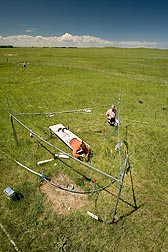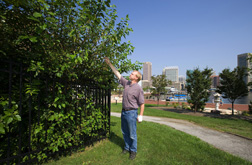Changing CO2 Promises Surprising
Changes in Plant Communities
High carbon dioxide (CO2) levels—an important contributor to global warming—have changed the botanical composition of the world’s grasslands, farms, and urban landscapes by increasing the growth, reproduction, or survival of some species more than others. The greatest changes may have already happened, so studies of past effects offer clues to future surprises.
Time Tunneling for Clues
Wayne Polley and Philip Fay, ecologists at the ARS Grassland Soil and Water Research Laboratory in Temple, Texas, offer an unprecedented look into the past and future: “Time tunnels” are used to expose a mix of tall prairie grasses and other plants to a gradient of CO2 levels, from the Ice Age to 2050 A.D. They use the greenhouse-like plastic-covered tunnels instead of open-top outdoor chambers in which plants are exposed to just one level of CO2 per chamber.
Polley says that he expects plants to show the most dramatic responses to concentrations of CO2 that are lower than today’s levels. “They are less sensitive per unit of CO2 at today’s levels and future levels.” This is why he says that the greatest changes have already happened, in terms of individual plant species’ responses. “But the cumulative effect of these individual responses on plant communities won’t be felt for years,” Polley says. “That is where the surprises will be.”
The changeover from nutritious prairie grasses to weedy shrubs like mesquite and sagebrush is a case in point of an early warning of future changes. Jack Morgan, a plant physiologist with ARS’s Rangeland Resources Research Unit in Fort Collins, Colorado, found that high CO2 levels are favoring cool-season grasses over warm-season grasses and weedy shrubs over native forage grasses. In open-top chambers at CO2 levels of 720 parts per million (ppm), about double today’s levels, Morgan found that the growth of fringed sage, a small weedy shrub, increased 40-fold in a Colorado shortgrass prairie.
Morgan’s findings confirm Polley’s research that high CO2 levels increase the water-use efficiency of plants, with the biggest benefit seeming to go to weedy shrubs and cool-season grasses. “High CO2 levels improve plant water-use efficiency by partially closing the leaves’ pores (stomates) and conserving water,” Morgan says. “To the extent that high CO2 levels encourage growth of undesirable plants like fringed sage, grassland vegetation will become less suitable for traditional uses such as livestock grazing.”
Heating Grasslands
Along with rising CO2 in Earth’s atmosphere, the climate is warming. As Morgan found, cool-season grasses do well with higher CO2 concentrations. Warm-season grasses, as their name implies, are adapted to warm temperatures. But there is little information on the combined effects of warming and rising CO2 on important forage grasses of the western Great Plains. So Morgan and colleagues designed a field experiment to examine how a native mixed-grass prairie—one composed of both warm- and cool-season grasses—responds to artificial warming and increased atmospheric CO2. This experiment relies on technology that releases CO2 above a native prairie to increase its concentration to 600 ppm. To produce higher temperatures, Morgan uses a field infrared heating system designed by Bruce Kimball, an ARS soil scientist in Arizona.
Morgan found that the combination of high CO2 and high temperatures are beginning to favor warm-season grasses, but he says that more years of experimentation will be needed to confirm these results. If the results are confirmed, they suggest that the benefit of CO2 for cool-season grasses may not hold in future warmer climates and that this important group of forage grasses may eventually decline.
20 Years of CO2 Effects on Plants
Steve Prior, a plant physiologist at the ARS National Soil Dynamics Laboratory in Auburn, Alabama, has also found that elevated CO2 can enhance growth of crops, forages, and invasive weeds, but the extent of the benefit will vary among plant species. Prior has just completed the world’s longest (10 years) open-top chamber study of CO2 effects on cropping systems.
“We found that no-till management under high CO2 increased soil carbon storage in the upper soil depths due to greater residue inputs,” Prior says.
He and Brett Runion, an ARS plant pathologist, and colleagues have also studied trees, such as longleaf pine. Similar to what Polley and Morgan found with cool-season grasses and weedy shrubs, they found that high CO2 improves drought tolerance and water-use efficiency. In their studies, longleaf pine grew more, while understory plants grew less, indicating that the makeup of the plant community may shift in a high-CO2 world. They also found chemical changes in pine needle litter, which could affect the insects and microbes that feed on them.
“These changes may alter carbon and nutrient cycling in natural systems,” Runion says.
Real-Life Time Tunnel Looks 50 Years Ahead
In Maryland, ARS plant physiologist Lew Ziska has findings that show that noxious weeds like ragweed are already outcompeting more desirable plants.
Ziska and former colleague Kate George have been using the “heat island” effects of Baltimore, Maryland, as a surrogate for a future warming in suburban and rural areas. In their own unique twist on a natural way to factor in rising temperatures, they have been studying plants growing in a transect from the heat of the City of Baltimore to the rural area outside of Frederick, Maryland, with a Baltimore suburban area in-between.
Over the 6-year study period, they found that temperatures in the heat island averaged about 4˚F warmer and had CO2 levels that were 20 percent higher than in the rural area. The temperatures and CO2 levels in the urban area are at about the levels predicted for the planet over the next 50 years.
They have seen the warmer temperatures and higher CO2 levels favoring weeds like ragweed and Canada thistle.
They created plots at each site by removing the existing soil and replacing the topsoil. This created disturbed sites that mimic farm fields left unplanted. They found that the combination of higher temperatures and higher CO2 levels sped up the rate of natural changes in plant communities triggered by disturbances.
In the first year of the study, plants that sprouted in the urban plots grew two to three times larger than those on the rural site. These were almost solely lambsquarters, a common non-native weed. After that, woody perennials became established until they composed 90 percent of the urban plant community, compared to 37 percent at the surburban site and 22 percent at the rural site. The woody perennials included trees such as red maple and red oak.
“This research shows that the weeds of the future aren’t going to be the mix of weeds we’re used to. There will be more invasives and different dominant weeds, not many of the native weeds that currently dominate weed communities,” Ziska says. And these weeds may pave the way for trees, shrubs, and other woody perennials.
Ziska also studied ragweed in the urban-to-rural transect area. He found that the urban area had earlier flowering of ragweed, earlier pollen production, and higher levels of pollen. The higher levels of pollen were partially offset by its weaker allergenicity.
“This shows that climate change—perhaps on a much finer scale than previously appreciated—can alter plant physiology and reproductive behaviors in ways that have potential implications for human health,” Ziska says.
How Global Change Affects Exotic Invasive Plants
At Fort Collins, new research by ARS ecologist Dana Blumenthal shows how climate change may be helping invasive weeds at the expense of native plants.
With colleagues at the University of North Carolina and in Czech Republic, Blumenthal studied 243 European plant species and their fungal and viral pests, both in Europe and in the United States.
He found that two key known causes of plant invasion—escape from natural enemies and increases in plant resources—act synergistically to favor fast-growing weed species. Adapted to environments rich in nitrogen, water, and CO2, these species have few defenses against enemies that keep them under control in their native lands.
But when these weeds from Europe end up in the United States—in a resource-rich environment but without their natural enemies—they easily outcompete fast-growing native plants.
This finding helps to explain the dramatic invasions by exotic plants occurring worldwide.
Unfortunately, fast-growing weeds are also the type of plant most favored by global change, since it increases the plant resources they are primed for, such as CO2 and soil nitrogen.
Land-use changes—caused by fire, plowing, overgrazing, agricultural development, or urbanization—remove plant competitors and make more resources available to exotic weeds. The soil disturbance itself also favors fast-growing weeds. “This implies that people may play a greater role in invasion than previously thought, by activities that increase plant resources,” Blumenthal says. “Successful management of plant invasions may require introducing plant enemies and limiting resource availability. Biological control may be most effective against the fast-growing exotic species precisely because they are so vulnerable to pests.”
Whether it’s less forage for raising cattle, less food and cover for declining grassland birds, or more and different weeds in our farms, rangelands, gardens, and lawns, global changes are already affecting us in dramatic ways and have already begun to reshape the world we live in.—By Don Comis, Agricultural Research Service Information Staff.
This research is part of Global Change, an ARS national program (#204) described on the World Wide Web at www.nps.ars.usda.gov.
To reach scientists mentioned in this article, contact Don Comis, USDA-ARS Information Staff, 5601 Sunnyside Ave., Beltsville, MD 20705-5129; phone (301) 504-1625, fax (301) 504-1486.
“Best of the Best” Global Climate Change Info Sources
National Agricultural Library’s Top Choices
Give yourself full points if you’ve already found your way to most, if not all, of the eight excellent resources listed below on global climate change. Librarians at ARS’s National Agricultural Library in Beltsville, Maryland, and Washington, D.C., chose these for Agricultural Research magazine readers as the top picks among what the World Wide Web and bookshelves have to offer.
Encyclopedia of Global Climate Change
Regarded as one of the best science reference books of 2008, this 3-volume compilation presents 750 scholarly articles covering the subject from diverse perspectives, including history, oceanography, biology, and geography.
Weathervane: A Climate Policy Blog From Resources For the Future
http://www.weathervane.rff.org
Particularly notable: Map-based overviews depicting levels of impact of climate change for different geographic areas, plus options for mitigation and their possible outcomes.
NASA Goddard’s Overview of Policy Websites
http://gcmd.gsfc.nasa.gov/Resources/pointers/glob_warm.html
Ideal for those with a penchant for policy, NASA’s site draws from government, private, and international resources for this wide-ranging selection of documents.
Agriculture’s Role In Greenhouse Gas Mitigation
http://tinyurl.com/lfl3kj
In their usual comprehensive fashion, Pew Center on Climate Change scholars from government and academia describe agriculture’s impact on carbon flow and storage and consider farming-based options to slow climate change. See especially the short overview at Agricultural and Forestlands: U.S. Carbon Policy Strategies.
Climate Change and U.S. Agriculture: The Impacts of Warming and
Extreme Weather Events on Productivity, Plant Diseases, and Pests
http://chge.med.harvard.edu/publications/documents/agricultureclimate.pdf
A team of renowned scientists from Harvard Medical School’s Center for Health and the Global Environment presents compelling examples of how climate change has affected agriculture.
Global Change Research in the USDA Forest Service
http://www.fs.fed.us/ne/global/fsgcrp/
As one of Earth’s most important reservoirs of carbon, forests unquestionably merit the detailed research described at this site.
Climate Change Books in the National Agricultural Library
http://tinyurl.com/DNAL-ClimatChng-BOOKS
This continually updated scan of the library’s growing collection presents the 50 newest citations first. Prepare to be impressed: NAL has more than 1,300 books on the subject.
Recent NAL database searches for journal articles on climate change
http://tinyurl.com/DNAL-ClimatChng-ARTICLES
You’ll get breadth, depth, and focus from NAL’s professionally designed database searches. If the 7,000-plus citations of relevant, English-language journal articles are a bit more than you need, a quick glance at the first 50 listings will make you current with the newest additions to this routinely updated list.—By Marcia Wood, Agricultural Research Service Information Staff.
"Changing CO2 Promises Surprising Changes in Plant Communities" was published in the November/December 2009 issue of Agricultural Research magazine.








